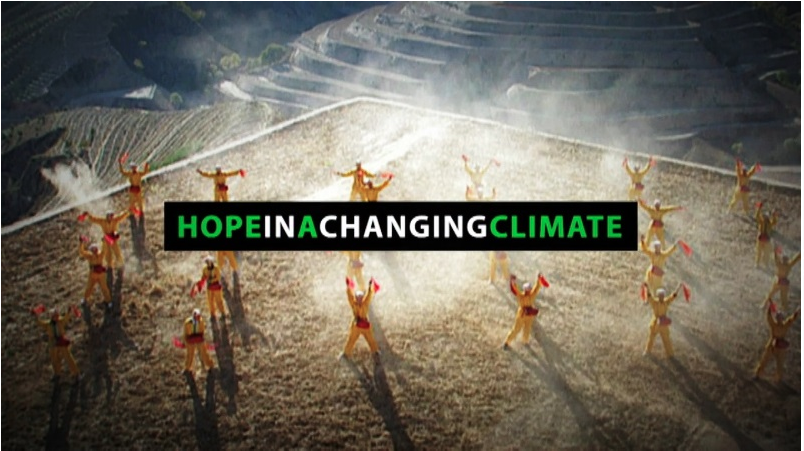Hope in a Changing Climate

Introduction
Hope in a Changing Climate is a documentary co-produced by The Open University and the Environmental Education Media Project (EEMP) for BBC World News.It reframes the debate on global warming by illustrating that large, decimated ecosystems can be restored. Success stories from Ethiopia, Rwanda and China prove that bringing large, decimated areas back from environmental ruin is possible, and the results are key to stabilising the earth’s climate, eradicating poverty and making sustainable agriculture a reality.
This BBC World documentary demonstrates that it is possible to rehabilitate large-scale damaged ecosystems, to restore ecosystem functions in areas where they have been lost, to fundamentally improve the lives of people who have been trapped in poverty for generations and to sequester carbon naturally.
This approach has been dramatically proven on the Loess Plateau in China, the highland area spanning some 640,000 square km in north central China (roughly the size of Belgium), where thousands of years of subsistence farming had resulted in a barren and infertile landscape. In 1995 the Chinese Government, with support from The World Bank, took drastic action to rehabilitate the plateau, and local people – seen as both perpetuators and victims of the devastation – became part of the solution. It is the birthplace of the Han Chinese, headwaters of The Yellow River and home to a new environmental and economic paradigm: this degraded ecosystem of more than 35,000 square km of land now teems with life and supports the sustainable economic, social and agricultural activities of its people.
Presented by John D. Liu, founder of the EEMP and creator of the film Lessons of the Loess Plateau, the film also uncovers the dramatic impact of similar projects in Ethiopia and Rwanda. Once the scene of devastating droughts in 1984, Ethiopia has used the same approach as that in China to begin bringing areas of arid land back to productivity and ecological balance. In Rwanda, where ecological degradation from over-farming of wetland areas saw the near failure of the country’s hydroelectricity supply, the Government has undertaken a similar project and seen vast improvements.
Further Information
Hope in a Changing Climate was first screened in Copenhagen at COP 15 and on BBC World. Since its launch, Hopehas been translated into French, German, Chinese, Vietnamese, Polish, Russian and Spanish. The film was officially chosen to commemorate the United Nations International Year of Forests, 2011. It was the most viewed video on the WaterChannel for more than 12 months in 2010 and 2011.
Hope won the Best Documentary Short Film Award at Green Screen in Vancouver, Canada, 2011. The International Festival of Environmental Film and Video accepted the film into its highly competitive global festival, June 2010. Hope was entered into United States: Best in Category: Ecosystem award in the prestigious International Wildlife Film Festival in Montana. In addition to the award for best ecosystem film, Hope also received six merit awards from IWWF (Presenter, Storytelling, Scientific Content, Conservation Initiative, Conservation Message and Human-Environment) in its 33rd annual film festival, May 2010, in Missoula, Montana;
Hope as E-course material is open source and free of charge under “Hope in a Changing Climate” on iTunes (with commentary by Open University faculty)
Hope was very recently featured on Natural Heroes, series 6.
The premiere of Hope on Earth Focus (United States) can be watched here.
Related resources
- Hope in a Changing Climate – Chinese
- Hope in a Changing Climate – Vietnamese
- Hope in a Changing Climate – Spanish
- Hope in a Changing Climate – German
- Hope in a Changing Climate – Russian
- Hope in a Changing Climate – Taiwanese
- Hope in a Changing Climate – Portuguese
- Hope in a Changing Climate – Polish
- Hope in a Changing Climate – French
- Read about Hope in a Changing Climate on the Open University website
- Visit the Environmental Education Media Project
- View work by John Dennis Liu (films, papers, presentations etc.)
(0) Comments
There is no content